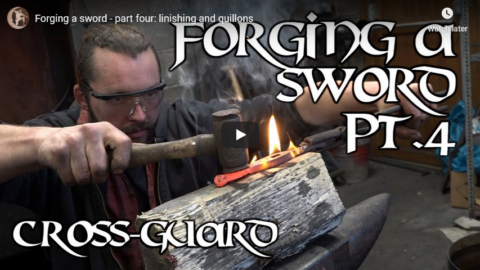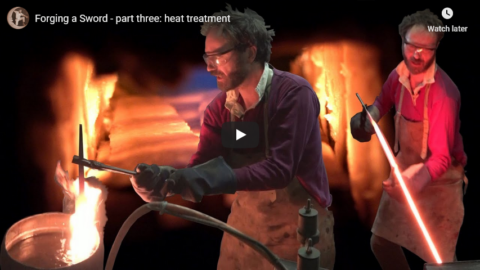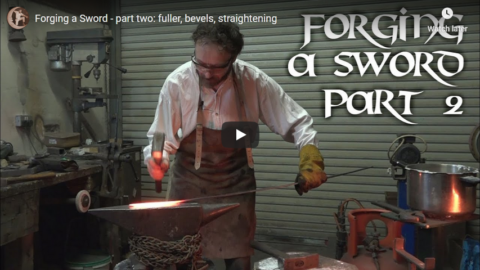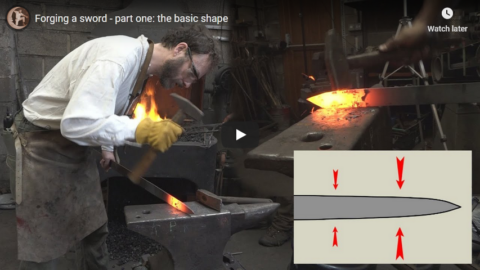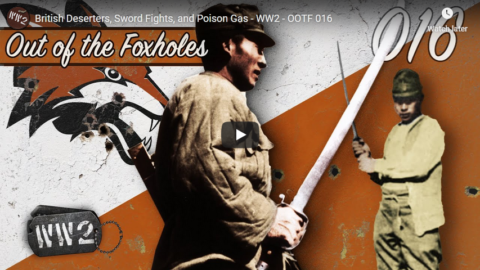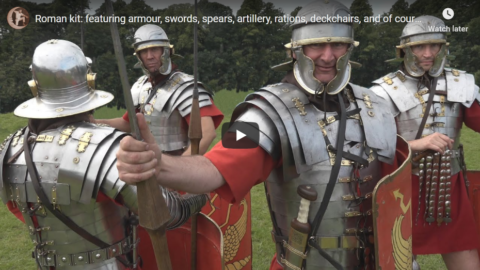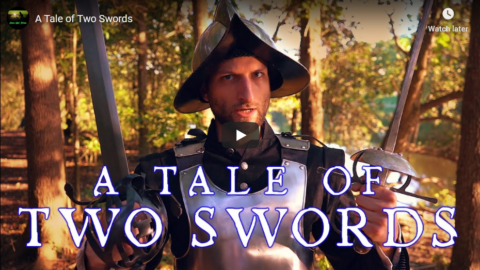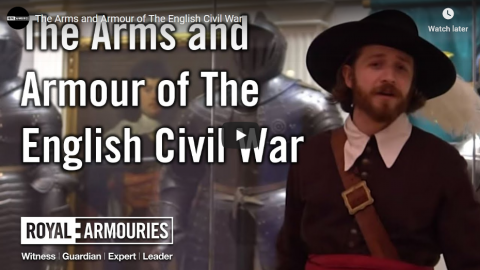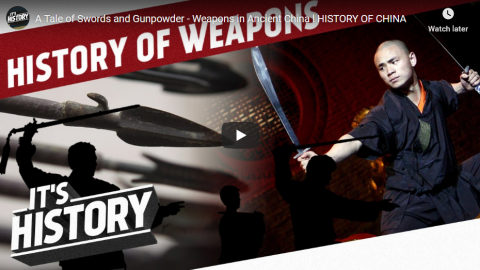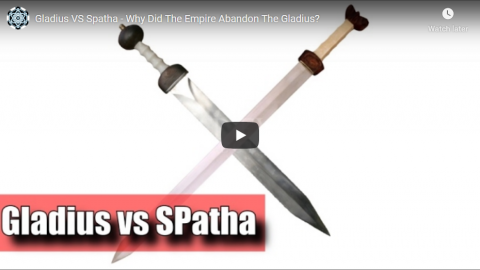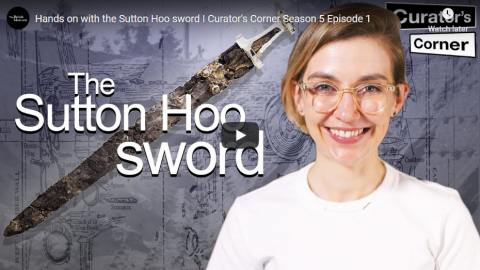Lindybeige
Published 6 Apr 2019Forging Arnander, my English bastard sword. I now start linishing (grinding/polishing), and make the quillons (crossguard) in a slightly fancy manner.
Support me on Patreon: https://www.patreon.com/Lindybeige
Had I been a better smith, I could have judged the amount that the quillons would extend by when being hammered out, and there wouldn’t have been the need to grind away so much metal. Without motorised tools, the medieval smiths would want to minimise grinding.
My tutor: Thom Leworthy.
Music used in this video: “Siegfried’s Funeral March” by Wagner.
Buy the music – the music played at the end of my videos is now available here: https://lindybeige.bandcamp.com/track…
More weapons and armour videos here: https://www.youtube.com/playlist?list…Lindybeige: a channel of archaeology, ancient and medieval warfare, rants, swing dance, travelogues, evolution, and whatever else occurs to me to make.
▼ Follow me…
Twitter: https://twitter.com/Lindybeige I may have some drivel to contribute to the Twittersphere, plus you get notice of uploads.
website: http://www.LloydianAspects.co.uk
August 31, 2020
August 28, 2020
August 25, 2020
August 22, 2020
August 21, 2020
British Deserters, Sword Fights, and Poison Gas – WW2 – OOTF 016
World War Two
Published 20 Aug 2020What happened to deserters in the British Army? Did Chinese and Japanese troops ever engage in sword to sword combat? Why didn’t Germany use poison gas on the battlefield? Find out the answers to all these questions in today’s Out of the Foxholes!
Join us on Patreon: https://www.patreon.com/TimeGhostHistory
Or join The TimeGhost Army directly at: https://timeghost.tvFollow WW2 day by day on Instagram @World_war_two_realtime https://www.instagram.com/world_war_two_realtime
Between 2 Wars: https://www.youtube.com/playlist?list…
Source list: http://bit.ly/WW2sourcesHosted by: Indy Neidell
Written by: Rune Væver Hartvig
Director: Astrid Deinhard
Producers: Astrid Deinhard and Spartacus Olsson
Executive Producers: Astrid Deinhard, Indy Neidell, Spartacus Olsson, Bodo Rittenauer
Creative Producer: Joram Appel
Post-Production Director: Wieke Kapteijns
Research by: Rune Væver Hartvig
Edited by: Jakub Janiec
Sound design: Marek KamińskiColorizations:
Mikołaj UchmanVisual Sources:
Imperial War Museums: HU 762498, Q 79508, El Alamein 1942, E 18542, B5114, MH 26392, F2845,
Library of Congress
Antoine from Flickr.com
National Archives NARA
Bundesarchive
Narodowe Archiwum Cyfrowe
The icons from Noun Project by: Milinda Courey, Arthur Shlain, Delwar Hossain, ahmad, Muhamad Ulum, Rooty, Simon Child, carlotta zampini, Wonmo Kang, Vectors Point, EucalypMusic:
“Break Free” – Fabien Tell
“Ancient Saga” – Max Anson
“Defeated” – Wendel SchererArchive by Screenocean/Reuters https://www.screenocean.com.
A TimeGhost chronological documentary produced by OnLion Entertainment GmbH.
July 30, 2020
Champagne Saber Time
Alton Brown
Published 7 May 2014A daring way to open a Champagne Bottle. Please do not try this at home.
Read the full instructions at https://altonbrown.com/sabering-champagne/
July 28, 2020
Roman kit: featuring armour, swords, spears, artillery, rations, deckchairs, and of course shoes
Lindybeige
Published 27 Jul 2020Go to https://expressvpn.com/lindybeige and find out how you can get three months free.
A video of re-enactors and their Roman kit. Sorry about the wind noise.
Support me on Patreon: https://www.patreon.com/Lindybeige
Here’s a link to the Ermine Street Guard – Britain’s foremost imperial Roman re-enactment group: http://www.erminestreetguard.co.uk
Was your re-enactment group featured? Ask for a link here!
Buy the music – the music played at the end of my videos is now available here: https://lindybeige.bandcamp.com/track…
Buy tat (merch):
https://outloudmerch.com/collections/…Lindybeige: a channel of archaeology, ancient and medieval warfare, rants, swing dance, travelogues, evolution, and whatever else occurs to me to make.
▼ Follow me…
Twitter: https://twitter.com/Lindybeige I may have some drivel to contribute to the Twittersphere, plus you get notice of uploads.
My website:
http://www.LloydianAspects.co.uk
June 21, 2020
A Tale of Two Swords
Atun-Shei Films
Published 19 Jun 2020Myles Standish and Benjamin Church were military commanders in 17th century colonial Massachusetts who lived a generation apart. Standish came over on the Mayflower, and commanded the militia of the Plymouth Pilgrims in the 1620s; Church lived his whole life in the New World, and led the crack troops that tracked down Metacomet, sachem of the Pokanoket Wampanoag, during King Philip’s War in the 1670s. Standish carried an elegant German rapier, while Church used a simple naval cutlass. What changed? And what story can these two swords tell about the men who wielded them?
Support Atun-Shei Films on Patreon ► https://www.patreon.com/atunsheifilms
Leave a Tip via Paypal ► https://www.paypal.me/atunsheifilms (Between now and October, all donations made here will go toward the production of The Sudbury Devil, our historical feature film)
#PlymouthPilgrims #KingPhilipsWar #AmericanHistory
Watch our film ALIEN, BABY! free with Prime ► http://a.co/d/3QjqOWv
Reddit ► https://www.reddit.com/r/atunsheifilms
Twitter ► https://twitter.com/atun_shei
Instagram ► https://www.instagram.com/atunsheifilms
Merch ► https://atun-sheifilms.bandcamp.com~REFERENCES~
[1] Jeremy Dupertuis Bangs: “Myles Standish, Born Where? (2010).” Sail 1620 https://web.archive.org/web/201011301…
[2] Nathaniel Philbrick: Mayflower (2006). Penguin Books, Page 59-60
[3] “Short Men ‘Not More Aggressive'” (2007). BBC News http://news.bbc.co.uk/2/hi/uk_news/65…
[4] Charles Francis Adams: The New English Canaan of Thomas Morton (1883). The Prince Society, Page 284 https://archive.org/details/newenglis…
[5] Philbrick, Page 164
[6] Philbrick, Page 151-152
[7] Benjamin Church: Entertaining Passages Relating to King Philip’s War, Tercentenary Edition (1975). Pequot Press, Page 67-73
[8] Church, Page 75
[9] Church, Page 105-106
[10] Church, Page 108
[11] Church, Page 140
[12] Lisa Brooks: Our Beloved Kin (2018). Yale University Press, Page 322
[13] Church, Page 142
[14] Douglas Edward Leach: Flintlock and Tomahawk (1958). Parnassus Imprints, Page 231
[15] Philbrick, Page 338
[16] Church, Page 170
[17] Leach, Page 237
[18] Brooks, Page 337
January 24, 2020
The Arms and Armour of The English Civil War
Royal Armouries
Published 21 Dec 2017The Royal Armouries’ English Civil War collection boasts an array of infantry and cavalry arms and armour from the 1640s. Delve into this turbulent historical period with a look at some cavalry arms and armour.
Where to find us:
⚔Website: https://royalarmouries.org/home
⚔Blog: https://blog.royalarmouries.org/
⚔Twitter: https://twitter.com/Royal_ArmouriesThe Royal Armouries is the United Kingdom’s national collection of arms and armour. On this channel, discover what goes on behind the scenes at the museum and to see our collection come to life. From combat demonstrations to jousting coverage to behind the scenes tours with our curators, we’ve got it covered.
Have a question about arms and armour? Feel free to leave us a comment and we’ll do our best to answer it.
November 4, 2019
A Tale of Swords and Gunpowder – Weapons in Ancient China l HISTORY OF CHINA
IT’S HISTORY
Published 12 Aug 2015Dao, Gun, Jian and Quiang are the four main traditional fighting weapons of China. Even though, the Chinese had already invented gunpowder by the end of the tenth century. So besides of having an arsenal of swords, spears, sabres, crossbows and bow and arrows, the Chinese military could also choose from cannons, rockets, mines and even handheld firearms. Still, close combat would remain the favoured means of battle for a long time. All about the history of Chinas weaponry now on IT’S HISTORY!
» SOURCES
Videos: British Pathé (https://www.youtube.com/user/britishp…)
Pictures: mainly Picture Alliance
Content:
Lu Gwei-Djen, Joseph Needham and Phan Chi-Hsing (1988): “The Oldest Representation of a Bombard”. In:
Technology and Culture 29 (3), pp. 594-605
Needham, Joseph (1986): Science and Civilization in China. Volume 5, Chemistry and Chemical Technology, Part 7, Military Technology; the Gunpowder Epic. Taipei
Tittmann, Wilfried/ Nibler, Ferdinand & John, Wolfgang ()
“Salpeter und Salpetergewinnung im Übergang vom Mittelalter zur Neuzeit”: http://www.ruhr-uni-bochum.de/technik…
Wang Ling (1947): “On the Invention and Use of Gunpowder and Firearms in China”. In: Isis 37 (3/4), 160-178» ABOUT US
IT’S HISTORY is a ride through history – Join us discovering the world’s most important eras in IN TIME, BIOGRAPHIES of the GREATEST MINDS and the most important INVENTIONS.» HOW CAN I SUPPORT YOUR CHANNEL?
You can support us by sharing our videos with your friends and spreading the word about our work.» CAN I EMBED YOUR VIDEOS ON MY WEBSITE?
Of course, you can embed our videos on your website. We are happy if you show our channel to your friends, fellow students, classmates, professors, teachers or neighbors. Or just share our videos on Facebook, Twitter, Reddit etc. Subscribe to our channel and like our videos with a thumbs up.» CAN I SHOW YOUR VIDEOS IN CLASS?
Of course! Tell your teachers or professors about our channel and our videos. We’re happy if we can contribute with our videos.» CREDITS
Presented by: Guy Kiddey
Script by: Martin Haldenmair
Directed by: Daniel Czepelczauer
Director of Photography: Markus Kretzschmar
Music: Markus Kretzschmar
Sound Design: Bojan Novic
Editing: Franz JänichA Mediakraft Networks original channel
Based on a concept by Florian Wittig and Daniel Czepelczauer
Executive Producers: Astrid Deinhard-Olsson, Spartacus Olsson
Head of Production: Michael Wendt
Producer: Daniel Czepelczauer
Social Media Manager: Laura Pagan and Florian WittigContains material licensed from British Pathé
All rights reserved – © Mediakraft Networks GmbH, 2015
September 22, 2019
Gladius VS Spatha – Why Did The Empire Abandon The Gladius?
Metatron
Published on 11 Feb 2017If the famous Gladius/rectangular Scutum combo had proven to be so effective for so many centuries why did the Late Empire Romans choose to abandon it in favour of a spatha/round shield combination? Here is what I think.
Gladius was one Latin word for sword, and is used to represent the primary sword of Ancient Roman foot soldiers.
A fully equipped Roman legionary after the reforms of Gaius Marius was armed with a shield (scutum), one or two javelins (pila), a sword (gladius), often a dagger (pugio), and, perhaps in the later Empire period, darts (plumbatae). Conventionally, soldiers threw javelins to disable the enemy’s shields and disrupt enemy formations before engaging in close combat, for which they drew the gladius. A soldier generally led with the shield and thrust with the sword. All gladius types appear to have been suitable for cutting and chopping as well as thrusting.
Gladius is a Latin masculine second declension noun. Its (nominative and vocative) plural is gladiī. However, gladius in Latin refers to any sword, not specifically the modern definition of a gladius. The word appears in literature as early as the plays of Plautus (Casina, Rudens).
Modern English words derived from gladius include gladiator (“swordsman”) and gladiolus (“little sword”, from the diminutive form of gladius), a flowering plant with sword-shaped leaves.
Gladii were two-edged for cutting and had a tapered point for stabbing during thrusting. A solid grip was provided by a knobbed hilt added on, possibly with ridges for the fingers. Blade strength was achieved by welding together strips, in which case the sword had a channel down the center, or by fashioning a single piece of high-carbon steel, rhomboidal in cross-section. The owner’s name was often engraved or punched on the blade.
August 30, 2019
Is The Roman Gladius (Sword) Really That Good?
August 21, 2019
QotD: The cult of Japanese cultural superiority
The Forged in Fire people have a new show: Knife or Die. It’s hard to discuss, because I don’t want to ridicule anyone. Any person with a desire to compete can show up with a big knife, and they will turn you loose on an obstacle course of things to cut. The first episode featured a Caucasian man wearing an Aikido costume and running shoes. I am serious. He carried a katana or “samurai sword,” even though aikido guys aren’t taught how to fight with swords. He hit a block of ice with it, and it bent in the middle.
That was a major blow to the Japan cult. Katanas are supposed to cut concrete blocks! At least that’s what they say in the Tokyo airport gift shop.
Why does aikido attract troubled people with unrealistic expectations? A high school friend of mine took up aikido. The Internet says he runs a dojo now. He gave his life to aikido. Unfortunately, aikido has a serious problem: it doesn’t work at all. Sure, you can twist people’s wrists and immobilize them if they are stupid enough to give you their hands, but everyone who has tried aikido in the ring has had his behind handed to him in individually wrapped slices. I can’t understand devoting your life to a martial art which can be defeated easily by 95% of angry untrained drunks. Would you open a store that only sold appliances that didn’t work?
Here are the words that start every single aikido demonstration: “Give me your hand.”
People are enchanted by Japan. They think the Japanese have deep wisdom we lack. They do, and here it is: do your job well and treat your elders and your boss with respect. That’s about it; the rest is hocus pocus. There are no Japanese superpowers. There is no chi. Steven Seagal has never once used magical Japanese aikido to fight a real fight because he knows he would experience humiliating losses.
Forged in Fire has its funny moments, but Knife or Die is a little too ridiculous to lampoon. It’s almost sad. It’s probably dangerous, too. Untrained eccentrics swinging razor-sharp knives of unknown quality in a timed test are a recipe for deep wounds and severe blood loss. I would hate to be in the studio when half of a knife goes flying off at 60 miles per hour.
Steve, “Knives for Knaves”, Tools of Renewal, 2018-05-31.
August 13, 2019
Hands on with the Sutton Hoo sword I Curator’s Corner Season 5 Episode 1
The British Museum
Published on 5 Aug 2019Sue Brunning and her trusty foam sword (newly dubbed Flexcalibur by commentator Pipe2DevNull) are back for another sword story. This time Sue takes us up close and personal with one of the most famous swords ever discovered.
Sue has also written a blog about Sutton Hoo available here: https://bit.ly/2yQkfYV (there are lots of other great articles there too!)
#CuratorsCorner #SwordswithSue #SuttonHooSue

